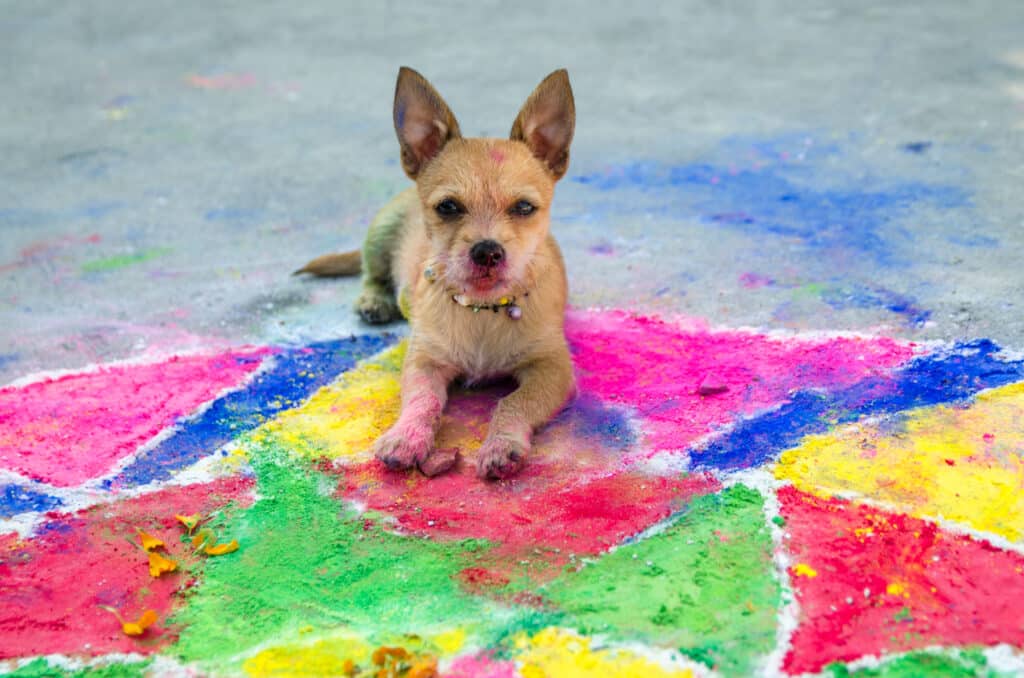The Tihar festival is often equated to the Hindu festival of Diwali, but it’s not quite the same. In fact, Diwali is better aligned with Dashain, although the Tihar comes right after.
This festival falls in the autumn, sometime between October and the end of November. It is closely related to the goddess Laxmi. Like Christmas or New Year’s Day in other places, it’s a huge family event. Worship and specific pujas are important, and for many Nepalis, this is one of the most festive times of the year.
For Nepalis abroad, like many of our Remitly customers, it can be a quiet time (unless they’re living in India). No matter what, though, it’s possible to make Tihar a special experience.
Tihar: The Reason for the Season
Tihar follows Dashain, the festival of lights, and is one of the most important festivals of the year in. Nepal. It’s a nostalgic time for Nepalis living far from home. Tihar brings family gatherings, sweets, gifts, firecrackers, and a break from exams.
But Tihar is more than a national holiday. It’s also a period of thanks, remembrance, and reconnecting.
One of the most well-known Tihar stories is about Yama, the god of death, reuniting with his sister Yamuna. When attempting to contact him, Yamuna sends a crow, a dog, and a cow—all important during the festival. Tihar is about keeping Yama satisfied and bringing prosperity into the household.
For the Newari community, it also marks the new year—which takes place on the fourth day of the festival.
The Five Days of Tihar
Tihar is a five-day festival, also known as Yama Panchak. This translates to “five days of Yama.”
Each day in Tihar has its own meaning and celebration:
- The first day of Tihar is Kaag Tihar, or crow puja, where people leave food for crows. Crows are often considered messengers of death. Feeding them on this day brings good luck.
- The second day is Kukur Tihar, where you give a garland to dogs and put a red tilak on their forehead.
- The third day is for Cow and Laxmi Puja, where cows and oxen are decorated and given certain foods. These animals are vital to sustaining agriculture and bringing prosperity and wealth. For that reason, this day is called Gai Tihar. Clay oil lamps are lit outside the home, and people come to visit. You’ll also hear firecrackers well into the night. This is a time to invite the goddess of wealth, Laxmi into the household.
- The fourth day of Tihar is called Goru Tihar, which is when families perform Govardhan Puja and Maha Puja. They also exchange Tihar gifts and have a family feast. This is also considered the New Year for the Newar community in the Kathmandu Valley.
- The fifth and last day, Bhai Tika, is geared towards brothers and sisters. Sisters add a tika to their brother’s foreheads. They may also give them garlands and small candy. Their brothers then do the same to them.
While some of these activities can be hard to celebrate while abroad, it’s not impossible!

13 Ways to Celebrate Tihar Abroad
There are many ways to celebrate Tihar outside of Nepal. Some ideas include:
- Lighting clay oil lamps inside and outside your home
- Adding decorative lights
- Cooking home-cooked food
- Inviting local friends for a meal or potluck
- Having a virtual celebration with your friends and family back home
- Listening to your favorite Nepali music or Hindu devotional songs
- Creating rangoli designs
- Hosting or sponsoring a community puja
- Donating money for a community meal
- Sending money back home for friends and family
- Watching your favorite Nepali movies
- Have an art contest within the community for children to draw their favorite aspect of Tihar
- Launch firecrackers, if allowed
There may be few cows that you can decorate abroad, to be fair. Still, you can add a tilak to the family dog during the Kukur Tihar. You can leave food for the local birds. You can get a gift for your sibling during Bhai Tika, and ask a pandit to perform the pujas in your household.
Celebrating in the US and Canada
Nepalis living in the United States, Canada, and Mexico comprise a small fraction of Nepalis living abroad. Still, that doesn’t mean there isn’t support for these immigrant communities.
Many Nepali organizations may organize local Tihar events, such as:
- The Association of Nepalis in the Americas
- America Nepal Society
- The Non-Resident Nepali Association, USA
- Nepali-American Friendship Association (NAFA)
You can find authentic ingredients from local Nepali, Indian, or Asian markets. Some will deliver to your doorstep, such as Nepali eMarket and the Mallko Store. These shops tend to have Dashain-Tihar sales as well, so keep an eye out for extra savings.
There are also many options for buying gifts for friends and family. Outside of Etsy and Amazon, you can also purchase books from Nepali publishers like Thuprai or Nirala Publications.
It’s also easier than ever to watch favorite Nepali films thanks to streaming services. You can find some free on YouTube. Cinema-Ghar also provides Nepali-language serials and movies for 500 Nepali rupees per year.
Celebrating in India
Over 600,000 Nepali expats live in India. This doesn’t include those originally living in Indian states, such as in Sikkim and West Bengal.
Celebrating Tihar is easier in India, given the similarities in culture and trade. Authentic foods and ingredients are available, even if they aren’t the same Nepali brands.
That said, many Nepali residents may choose to travel back home to celebrate with the family. They may even go on to Sikkim and West Bengal for a nice holiday vacation.
Sending Money to Nepal
You may decide to send physical gifts to your friends and family for Tihar—especially for your nieces and nephews. But there are times you want to send money, too.
